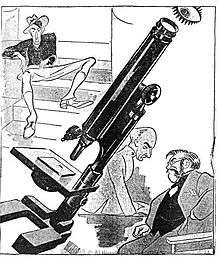Yellow Jack (play)
| Yellow Jack | |
|---|---|
 Al Hirschfeld drawing from the Herald Tribune, March 11, 1934 (James Stewart in upper-left) | |
| Written by |
Sidney Howard Paul de Kruif (collaborator) |
| Date premiered | March 6, 1934 |
| Original language | English |
| Subject | Major Walter Reed of the U.S. Army worked to diagnose and treat yellow fever (called “yellow jack”) in Cuba in 1898–1900 |
| Genre | Drama |
| Setting | New York today, London in January of 1929, West Africa in June of 1927, Cuba in 1900, and London in September of 1929 |
Yellow Jack is a 1934 docudrama play produced by Guthrie McClintic and a 1938 Hollywood movie by the same name. Both were co-written by Sidney Howard and Paul de Kruif (the former a Pulitzer- and Oscar-winning playwright and screenwriter; the latter a well-known microbiologist and author). The play is the work of Sidney Howard and is based on a chapter in Paul de Kruif’s 1927 book Microbe Hunters.[1]
James Stewart in his first dramatic role stars as Pvt. John O'Hara, a role reprised by Robert Montgomery in the 1938 film. Stewart later stated this role convinced him to continue his acting career during a time he recalled that "From 1932 through 1934...I'd only worked three months. Every play I got into folded."[2] The experience led him to stay with acting and he first entered movies later that year in The Murder Man. Caricaturist Al Hirschfeld while covering the play for the New York Herald Tribune drew his first of 13 drawings (and only one from a play) he made over the course of Stewart's career.[3]
The play opened at the opulent Martin Beck Theatre on March 6, 1934, and ran for 79 performances. The Martin Beck was renamed in 2003 for Al Hirschfeld, who drew the caricature for Yellow Jack. Prior to its debut, Herman Bernstein's Jewish Daily Bulletin covered the play, thereby giving it approval for not containing anti-semitic elements.[4]
Due to the high cost of repertory production, in 1947 New York's American Repertory Theatre revived Yellow Jack for a four-week run at the International Theatre.[5]
Synopsis
After the Spanish-American War, in which more U. S. soldiers were killed by yellow fever (known as Yellow Jack) than in battle, the War Department sent a medical commission to Cuba to find, if possible, the cause and cure of this deadly tropical disease. The commission was headed by Dr. Walter Reed. With him was Dr. James Carroll. In Cuba they found Dr. Jesse Lazear, European-trained microbiologist, and Cuban Dr. Aristides Agramonte.
Limited in its experiments by the fact that animals are immune to Yellow Jack and embroiled in government interference, Reed decides that the only way to test the theory is to expose his own men to the disease. Needing human volunteers, Private John O'Hara is willing to allow Dr, Reed to experiment on him.
Reception
Debuting on 6 Mar, 1934, the play ran through May for a modest 79 performances. It generally received positive reviews, but the subject had limited popular appeal.[6]
Cast
- James Stewart as Medical Corps Pvt. O'Hara
- John Miltern as Major Walter Reed
- Edward Acuff as Pvt. McClelland
- Wylie Adams as Kraemer, as a Commissary Sergeant and as a member from the Rockefeller Foundation
- Jack Carr as Chambang, a Native Laboratory Assistant
- Eduardo Ciannelli as Aristides Agramonte, a Member of the American Yellow Fever Commission
- Francis Compton as a Major of the Royal Air Force
- Charles Gerard as Adrian Stokes, of the West African Yellow Fever Commission, Rocke
- Lloyd Gough as a Laboratory Assistant and as an Army Chaplain
- Harold Hoffat as Roger P. Ames. an Asst. Surgeon
- Colin Hunter as an Official of the Kenya Colony Government
- Bernard Jukes as a Laboratory Assistant
- Whitford Kane as Dr. Carlos Finlay
- Robert Keith as Jesse W. Lazear, a member of the American Yellow Fever Commission
- Geoffrey Kerr as Stackpoole
- Sam Levene as Pvt. Busch
- Richie Ling as Colonel Tory of the Marine Hospital Corps
- Barton MacLane as James Carroll, a member of the American Yellow Fever Commission
- Myron McCormick as Pvt. Brinkerhof
- Millard Mitchell as Pvt. William H. Dean
- Jock Munro as a Laboratory Assistant
- George Nash as Major William Crawford Gorgas
- Robert Shayne as Harkness and as Major Cartwright
- Frank Stringfellow as an Orderly
- Clyde Walters as an Orderly
- Katherine Wilson as Miss Blake, a Special Nurse in Charge of the Yellow Fever Ward
See also
- Yellow Jack (1938 film)
References
- ↑ De Kruif, Paul (1927). Microbe Hunters. Jonathan Cape. ISBN 0156027771.
- ↑ Eliot, Mark. Jimmy Stewart: A Biography. New York: Random House, 2006. ISBN 978-1-40005-222-6 (pg. 58).
- ↑ http://www.alhirschfeldfoundation.org/piece/yellow-jack#result_info_7396
- ↑ http://www.jta.org/1934/03/06/archive/yellow-jack
- ↑ http://query.nytimes.com/gst/abstract.html?res=9903E1DE103EEE3BBC4F51DFB466838C659EDE
- ↑ Encyclopedia of the American Theatre
Further reading
- Hochman, Stanley (1984). McGraw-Hill Encyclopedia of World Drama: An International Reference Work in 5 Volumes, Volume 1. McGraw-Hill Publishing. ISBN 0070791694.
External links
- Yellow Jack at the Internet Movie Database
- Yellow Jack (1934 production) at the Internet Broadway Database
- James Stewart at the Internet Broadway Database
- Guthrie McClintic biography and films
- TIME Magazine review: Mar. 19, 1934